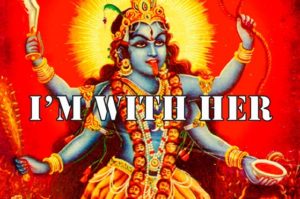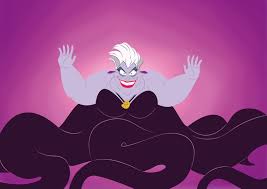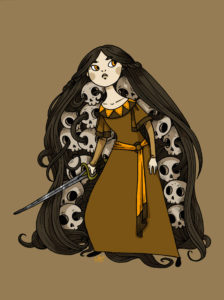Christians this month are observing the season of Lent, a period of self-examination and repentance, and this Episco-pagan is among them. If the Christian part should ever drop out of my identity, Lent would be the last to go. It’s always felt, for me, like opening up more breathing room in our shared spiritual space; a rare time to acknowledge sadness and confusion in a publicly supportive environment, and the luxury of introspection in liberal churches that are usually so focused on outward social action. (Plus, forty days is really the outer limit of how long I can maintain good habits, like eating fewer carbs and not biting my nails.)
On Ash Wednesday, the multi-author blog Feminism and Religion offered this positive re-thinking of repentance as creative tension: accepting imperfection as our natural state, while always striving to grow beyond it. It reminds me of the dialectical-behavioral therapy affirmation (I’m paraphrasing Marsha Linehan here), “I accept you just as you are and I believe you can change.” One could say this attitude is less prideful than the traditional fall-from-grace narrative that implies we were supposed to be perfect. Religion professor Natalie Weaver writes in “A Lenten Reflection”:
Today is Ash Wednesday, where people the world over are reminded that they are born of dust and destined to return to dust. In the meanwhile, we will fast and repent of all the wrongs wrought by our doings and omissions. And, while my own disposition sort of naturally enters into that almost masochistic self-reflection, another part of me feels the strong urge to resist that burden. This is not to say that I eschew moral agency or culpability. Rather, it is to resist an anthropology of sin and fall. I sooner would see an anthropology of effort and crawling towards walking. I sooner would embrace the idea that creaturely life is not perfected, especially while it is still in process, and that sin and error are actually manifestations of the imperfect but noble effort of the child trying to stand; the adult trying to be responsible; the elderly trying to give advice, and all as much as possible for as long as possible.
The great evils of this world are driven by desire for godlike domination and access. They demonstrate the craven lust to own land and bodies and resources and control. They are the unchecked will of the self striving to create the world, writ small or large, after one’s own image. But, isn’t there something of this grandiose self (construed as both individual and corporate, tribal, and national identities) also present in the narcissistic gaze inward, where I try to determine my imperfections and imagine myself without them as in some pre-fallen or post-fallen way, heavenly state? Does the obsession with sin not betray some deeper sort of god-complex?
I would like to suggest that we are better served by a less audacious theology. It is wise to be a creature, recognizing the scope and limit of one’s influence and place. We harm ourselves when we batter our souls with all that we should have done and all that we did not do. And, even such an exercise diligently undertaken will not change in a lasting corrective sense the inevitability that we’ll arrive at this same bend next year. The truth is, while we all search, we don’t know in an absolute sense for what we search; we hope for that which is beyond our imaginations.
Among the topics of my soul-searching this year is racism and my complicity in it as a white person. I have mixed feelings about “privilege” language because being treated decently is a universal right, though one that is unfortunately far from universally enjoyed. “Privilege” has connotations of something that was handed to you when you should have earned it, or a coddling of immature sensitivities. But for now, it’s the best commonly-understood shorthand to convey that inequality is structural, not just about personal animus.
In the words of former Defense Secretary Donald Rumsfeld, white privilege is partly about the “unknown unknowns–the ones we don’t know we don’t know.” We have no reason to question popular narratives of American history that could be dangerously wrong. We might fall for hate-mongering political strategies against a marginalized group without recognizing that they’re right out of the KKK’s playbook.
For example, in this 2014 post from The Weekly Sift, “Not a Tea Party, a Confederate Party”, freelance journalist and amateur historian Doug Muder convincingly argues that Reconstruction was the second phase of the Civil War–and the North lost.
The Civil War was easy to misunderstand at the time, because there had never been anything like it. It was a total mobilization of society, the kind Europe wouldn’t see until World War I. The Civil War was fought not just with cannons and bayonets, but with railroads and factories and an income tax.
If the Napoleonic Wars were your model, then it was obvious that the Confederacy lost in 1865: Its capital fell, its commander surrendered, its president was jailed, and its territories were occupied by the opposing army. If that’s not defeat, what is?
But now we have a better model than Napoleon: Iraq.
After the U.S. forces won on the battlefield in 1865 and shattered the organized Confederate military, the veterans of that shattered army formed a terrorist insurgency that carried on a campaign of fire and assassination throughout the South until President Hayes agreed to withdraw the occupying U. S. troops in 1877. Before and after 1877, the insurgents used lynchings and occasionalpitchedbattles to terrorize those portions of the electorate still loyal to the United States. In this way they took charge of the machinery of state government, and then rewrote the state constitutions to reverse the postwar changes and restore the supremacy of the class that led the Confederate states into war in the first place. [2]
By the time it was all over, the planter aristocrats were back in control, and the three constitutional amendments that supposedly had codified the U.S.A’s victory over the C.S.A.– the 13th, 14th, and 15th — had been effectively nullified in every Confederate state. The Civil Rights Acts had been gutted by the Supreme Court, and were all but forgotten by the time similar proposals resurfaced in the 1960s. Blacks were once again forced into hard labor for subsistence wages, denied the right to vote, and denied the equal protection of the laws. Tens of thousands of them were still physically shackled and subject to being whipped, a story historian Douglas Blackmon told in his Pulitzer-winning Slavery By Another Name.
So Lincoln and Grant may have had their mission-accomplished moment, but ultimately the Confederates won. The real Civil War — the one that stretched from 1861 to 1877 — was the first war the United States lost.
The missed opportunity. Today, historians like Eric Foner and Douglas Egerton portray Reconstruction as a missed opportunity to avoid Jim Crow and start trying to heal the wounds of slavery a century sooner. Following W.E.B. DuBois’ iconoclastic-for-1935 Black Reconstruction, they see the freedmen as actors in their own history, rather than mere pawns or victims of whites. As a majority in Mississippi and South Carolina, and a substantial voting bloc across the South, blacks briefly used the democratic system to try to better their lot. If the federal government had protected the political process from white terrorism, black (and American) history could have taken an entirely different path.
In particular, 1865 was a moment when reparations and land reform were actually feasible. Late in the war, some of Lincoln’s generals — notably Sherman — had mitigated their slave-refugee problem by letting emancipated slaves farm small plots on the plantations that had been abandoned by their Confederate owners. Sick or injured animals unable to advance with the Army were left behind for the slaves to nurse back to health and use. (Hence “forty acres and a mule”.) Sherman’s example might have become a land-reform model for the entire Confederacy, dispossessing the slave-owning aristocrats in favor of the people whose unpaid labor had created their wealth.
Instead, President Johnson (himself a former slave-owner from Tennessee) was quick to pardon the aristocrats and restore their lands. [3] That created a dynamic that has been with us ever since: Early in Reconstruction, white and black working people sometimes made common cause against their common enemies in the aristocracy. But once it became clear that the upper classes were going to keep their ill-gotten holdings, freedmen and working-class whites were left to wrestle over the remaining slivers of the pie. Before long, whites who owned little land and had never owned slaves had become the shock troops of the planters’ bid to restore white supremacy.
This history is even more relevant in the Trump era than when Muder wrote it three years ago, because false narratives of the reasons for racial and economic inequality drive much of the Trump-supporters’ policy initiatives and self-image. The second half of the article warns:
But the enduring Confederate influence on American politics goes far beyond a few rhetorical tropes. The essence of the Confederate worldview is that the democratic process cannot legitimately change the established social order, and so all forms of legal and illegal resistance are justified when it tries…
…The Confederate sees a divinely ordained way things are supposed to be, and defends it at all costs. No process, no matter how orderly or democratic, can justify fundamental change.
When in the majority, Confederates protect the established order through democracy. If they are not in the majority, but have power, they protect it through the authority of law. If the law is against them, but they have social standing, they create shams of law, which are kept in place through the power of social disapproval. If disapproval is not enough, they keep the wrong people from claiming their legal rights by the threat of ostracism and economic retribution. If that is not intimidating enough, there are physical threats, then beatings and fires, and, if that fails, murder.
That was the victory plan of Reconstruction. Black equality under the law was guaranteed by the 14th Amendment. But in the Confederate mind, no democratic process could legitimate such a change in the social order. It simply could not be allowed to stand, and it did not stand.
In the 20th century, the Confederate pattern of resistance was repeated against the Civil Rights movement. And though we like to claim that Martin Luther King won, in many ways he did not. School desegregation, for example, was never viewed as legitimate, and was resisted at every level. And it has been overcome. By most measures, schools are as segregated as ever, and the opportunities in white schools still far exceed the opportunities in non-white schools.
Today, ObamaCare cannot be accepted. No matter that it was passed by Congress, signed by the President, found constitutional by the Supreme Court, and ratified by the people when they re-elected President Obama. It cannot be allowed to stand, and so the tactics for destroying it get ever more extreme…
Meanwhile, at The TransAdvocate, this 2016 post by Cristan Williams looks at the history behind “Bathroom Bills and the Dialectic of Oppression”. In an interview with Princeton lecturer Dr. Gillian Frank, Williams details “the ways anti-equality groups have historically cast oppressed groups as voyeurs and/or perverts, warning the public that should an oppressed group have equality, bad things may happen in public bathrooms.” Klan spokesmen in the 1960s raised the specter of white women catching “Negro diseases” from integrated restrooms; opponents of the Equal Rights Amendment in the 1980s similarly warned that gender equality would let gay men spread AIDS in public bathrooms and locker rooms. “The political argument that supporting the discrimination of a minority group equates to saving children from harm traces its rhetorical roots back to Jim Crow laws.” Williams quotes Frank as saying:
Analyzing the racial origins of [Save Our Children’s (SOC)] activism and the gay rights response to it in the 1970s reveals a migration of conservative ideas and activists from race-based conflicts to gender- and sexual-based conflicts. SOC’s discourse of child protection embodied a protean logic of family privacy against queer sexuality. That strategy was, in part, learned from southern US resistance to desegregation, dating back to the Civil War, which used the language of privacy and family protection to address issues of race.
(“Save Our Children” was Anita Bryant’s anti-gay activist group in the 1970s.) Frank continues:
The use of mass media to aid in the construction of oppressed groups as sexual threats can be traced back to a specific political narrative initially used against Black Americans. The KKK was perhaps the first to enjoy the use of mass multimedia to inspire the dominate population to view members of an oppressed group as a potential sexual threat. In 1915 the KKK was featured in the movie blockbuster, Birth of a Nation. The movie, originally titled The Clansman, features a White man portrayed as a Black man who tries to rape a White woman. The movie earned more than 10 million dollars (more than 235 million in 2016 dollars) and helped popularize the Black rapist trope within the public consciousness…
…The Republican Party centered their political dialectic upon this trope in the 1988 presidential race between George Bush and Michael Dukakis… Bush portrayed Dukakis’ support of racial equality as an endorsement of the rape of White women by Black men through attack ads featuring Willy Horton. Horton, a Black man who raped and killed a White woman, was constructed to be a central figure in the Dukakis political team. Bush’s aid, Lee Atwater said, “By the time we’re finished, they’re going to wonder whether Willie Horton is Dukakis’ running mate.”
Imagery used to support anti-transgender politics likewise draws upon the construction of transgender women as sexual threats. Political advertisements against Houston’s equality ordinance consistently featured the message that should trans women be protected from harassment and discrimination, little girls would be raped. The Houston Chronicle reported, “Opponents of the ordinance… have flooded radio and TV with ads saying the law gives men dressed in women’s clothing, including sexual predators, the ability to enter a woman’s restroom. On Tuesday, the group released a TV spot that closes with a man bursting into a stall occupied by a young girl.”
This political dialectic functions to erode the oppressed group’s humanity to the point wherein their mere existence in society is enough to warrant calls for violence…
Visit Cristan’s blog and Twitter feed for more articles about transgender rights and the surprising history of trans-inclusive radical feminism.





